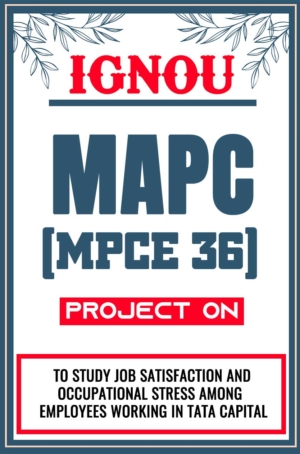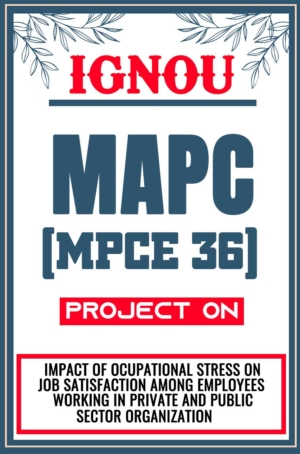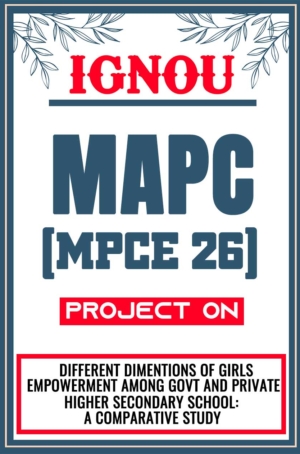Buy IGNOU MAPC Project for MPCE 16/26/36
The course IGNOU MAPC Project for MPCE 16/26/36 offers students an engaging introduction to the essential topics in psychology. Throughout this study of human behavior and the mind, you will gain insight into the history of the field of psychology, as well as explore current theories and issues in areas such as cognition, motivation, and wellness. This course IGNOU MAPC Project attracts many students because it not only deals with human and animal behavior but also increases self-awareness and logic among them. IGNOU MA PSYCHOLOGY PROJECT can be termed as both arts and science because its study is processed by scientific methods to study human behavior.
Whatsapp us to get the Personalized (Customized) IGNOU MAPC Project Report and Synopsis
Download Link for IGNOU MAPC Project (MPCE 16/26/36 PDF)
What is the process for getting your IGNOU MAPC Project proposal approved?
The process for getting your project proposal approved for the IGNOU MAPC projects under MPCE 16, MPCE 26, and MPCE 36 involves several steps:
1. Topic Selection:
- Choose a topic relevant to your specialization (Clinical Psychology, Counseling Psychology, or Industrial and Organizational Psychology).
- Ensure the topic is feasible, manageable within the given timeframe, and has sufficient literature available.
2. Literature Review:
- Conduct a preliminary literature review to understand the existing research and identify gaps that your project can address.
- Summarize key studies, theories, and concepts related to your chosen topic.
3. Proposal Drafting:
Prepare a detailed project proposal that includes the following sections:
- Title: A clear and concise title reflecting the research topic.
- Introduction: Background information and rationale for the study.
- Objectives: Specific research questions or hypotheses you intend to explore.
- Literature Review: Summary of relevant studies and theoretical frameworks.
- Methodology: Detailed plan for data collection and analysis, including sample size, tools, and procedures.
- Expected Outcomes: Potential findings and their implications.
- Timeline: Estimated timeline for completing each phase of the project.
- References: List of cited literature in APA format.
4. Supervisor Consultation:
- Contact your assigned project supervisor or guide.
- Share your initial proposal draft and seek feedback.
- Incorporate any suggestions or revisions provided by your supervisor.
5. Proposal Submission:
- Prepare the final version of your proposal incorporating the supervisor’s feedback.
- Follow any specific format or submission guidelines provided by IGNOU.
- Submit the proposal to your study center or through the designated online portal, if applicable.
6. Review and Approval:
- The submitted proposal will be reviewed by your supervisor and possibly a project committee.
- You may be asked to make further revisions based on their feedback.
- Once the proposal meets all the requirements, it will be formally approved.
7. Formal Approval:
- Receive formal approval of your project proposal, usually in writing or via email.
- Keep a copy of the approval for your records and proceed with the research phase of your project.
8. Start Your Research:
- Begin your research as outlined in your approved proposal.
- Maintain regular contact with your supervisor for guidance and support throughout the research process.
IGNOU MAPC Project Topics for MPCE 16/26/36
- Academic Stress And Emotional Stability Among Obedient And Disobedient Students
- Study Of Depression And Suicidal Ideation Of Young And Middle Adulthood Women
- Occupational Stress, Job Burnout And Psychological Health Among Primary And High School Teachers
- Examination Anxiety In Relation To Self Esteem And Resilience Among Students
- Impact Of Social Media On Body Image, Self Esteem And Adjutment Level Of College Students
- A Study On Family Climate On Mental Health Of Students
- A Study Of Stress, Anxiety And Depression Among Nursing Students During Covid 19
How do you analyze the data collected for your IGNOU MAPC Project?
Analyzing the data collected for your IGNOU MAPC project involves several key steps, which will vary depending on whether you are using quantitative, qualitative, or mixed methods. Here is a detailed guide on how to analyze your data:
Quantitative Data Analysis
1. Data Preparation:
- Data Cleaning: Check for and address any missing values, errors, or outliers in your dataset.
- Coding: If your data includes categorical variables, convert them into numerical codes for analysis.
2. Descriptive Statistics:
- Measures of Central Tendency: Calculate the mean, median, and mode to summarize the data.
- Measures of Dispersion: Determine the range, variance, and standard deviation to understand the spread of the data.
- Frequency Distributions: Create frequency tables and histograms to visualize the distribution of your data.
3. Inferential Statistics:
- Hypothesis Testing: Use statistical tests (e.g., t-tests, ANOVA, chi-square tests) to test your research hypotheses.
- Correlation and Regression: Analyze relationships between variables using Pearson correlation or regression analysis.
- Software Tools: Use software like SPSS, R, or Excel for statistical analysis.
4. Interpretation:
- Results Presentation: Summarize the findings using tables, charts, and graphs.
- Discussion: Interpret the results in the context of your research questions and literature review.
Qualitative Data Analysis
1. Data Preparation:
- Transcription: Transcribe interviews, focus group discussions, or observational notes.
- Organizing Data: Organize your data into manageable units (e.g., by participant, by theme).
2. Coding:
- Open Coding: Identify and label concepts or themes that emerge from the data.
- Axial Coding: Group related codes into categories and subcategories.
- Selective Coding: Identify core categories that relate to your research questions.
3. Thematic Analysis:
- Identify Themes: Look for patterns or themes that recur across your data.
- Develop Categories: Group themes into broader categories to develop a coherent narrative.
- Software Tools: Use qualitative data analysis software like NVivo, ATLAS.ti, or MAXQDA for coding and theme development.
4. Interpretation:
- Narrative Summary: Provide a detailed narrative that explains the themes and categories identified.
- Quotes and Examples: Use quotes from participants to illustrate key themes.
- Discussion: Relate the findings to your research questions and existing literature.
Mixed Methods Analysis
1. Integrating Data:
- Sequential Analysis: Analyze quantitative and qualitative data separately and then integrate the findings.
- Concurrent Analysis: Analyze both types of data simultaneously and look for points of convergence or divergence.
2. Data Triangulation:
- Cross-Validation: Use data from different sources or methods to validate your findings.
- Complementarity: Use qualitative data to explain or provide context to quantitative findings, and vice versa.
3. Interpretation:
- Combined Narrative: Develop a comprehensive narrative that integrates both quantitative and qualitative findings.
- Discussion: Discuss how the integrated findings address your research questions and contribute to the literature.
What is the submission process for the IGNOU MAPC Project report?
The submission process for the IGNOU MAPC project report involves several steps. Here is a detailed guide to ensure you complete and submit your project report correctly:
1. Complete the Project Report:
- Ensure that your project report is finalized, including all sections such as the title page, acknowledgments, table of contents, introduction, literature review, methodology, data analysis, results, discussion, conclusion, references, and appendices.
2. Formatting:
- Follow the specific formatting guidelines provided by IGNOU, which typically include font size, spacing, margins, and referencing style (usually APA format).
3. Supervisor Review:
- Submit the final draft of your project report to your supervisor for review.
- Incorporate any feedback or suggestions provided by your supervisor.
4. Prepare Required Documents:
- Project Report: Prepare multiple copies of the final report as required (usually one hard copy for submission and one for your records).
- Project Proposal Approval Letter: Include a copy of the proposal approval letter from your supervisor.
- Declaration Form: Fill out and sign the declaration form provided by IGNOU, stating that the work is original and not plagiarized.
- Certificate of Originality: Obtain a certificate of originality signed by your supervisor.
5. Binding:
- Bind the final project report as per IGNOU guidelines. Typically, a spiral or soft binding is acceptable unless specified otherwise.
6. Submission to Study Center:
- Submit the bound project report along with the required documents to your designated study center.
- Ensure you meet the submission deadline set by IGNOU for your course and semester.
7. Online Submission (if applicable):
- Some programs may require an online submission of the project report. Check with your study center or IGNOU’s official guidelines for details.
- If online submission is required, upload the digital copy of your report and any other required documents to the designated portal.
8. Acknowledgment Receipt:
- Obtain an acknowledgment receipt from the study center confirming the submission of your project report.
- Keep this receipt for your records as proof of submission.
9. Wait for Evaluation:
- Your project report will be evaluated by your supervisor and/or external examiners.
- Be prepared for a possible viva voce (oral examination) where you may need to discuss and defend your project findings.
10. Check Results:
- After evaluation, check the status of your project report and your overall grade on the IGNOU official website or through your study center.
What is the role of the appendix in your IGNOU MAPC Project report?
The appendix in your project report serves as a supplementary section that includes additional material supporting the main text of your report but is not essential to the main findings and discussions. The appendix provides a place for detailed information that would otherwise disrupt the flow and readability of the main body of the report. Here’s a detailed look at the role and contents of the appendix:
Role of the Appendix
1. Supporting Information:
- The appendix contains detailed information that supports your research but is too lengthy or detailed to include in the main sections. This allows the main text to remain focused and concise while still providing comprehensive details for readers who are interested.
2. Documentation of Procedures:
- It documents the procedures and tools used in your research, ensuring transparency and reproducibility. This is particularly important in psychological research where detailed methodology can significantly affect the results.
3. Providing Raw Data:
- The appendix is a place to include raw data or large datasets that are summarized in the main text. This allows readers to see the full data set used in your analysis without cluttering the main report.
4. Inclusion of Supplementary Material:
- It includes supplementary material such as questionnaires, interview transcripts, consent forms, detailed statistical tables, and additional graphs or charts. These materials provide further evidence and support for your findings.
Contents of the Appendix
1. Raw Data:
- Include raw data tables, original survey responses, or detailed observational notes. This helps validate your data analysis and provides a resource for future researchers.
2. Questionnaires and Surveys:
- Include copies of any questionnaires, surveys, or assessment tools used in your research. This helps in understanding how data was collected and allows for replication of the study.
3. Interview Transcripts:
- Provide full transcripts of interviews or focus group discussions. This ensures that your qualitative data analysis can be reviewed and verified.
4. Detailed Methodological Descriptions:
- Include detailed descriptions of experimental procedures, sampling methods, and any instruments or software used in your study. This level of detail can help others replicate your study or understand the nuances of your methodology.
5. Statistical Tables and Calculations:
- Provide detailed statistical tables, including any intermediate calculations or additional statistical analyses that support your findings. This transparency strengthens the credibility of your research.
6. Consent Forms:
- Include blank copies of consent forms used to obtain participant permission. This demonstrates ethical compliance in your research.
7. Additional Graphs and Charts:
- Include any additional graphs, charts, or visual aids that support your findings but are not critical to the main text. These can help readers better understand complex data.
8. Supplementary Literature:
- Include supplementary literature or reference material that provides additional context or background to your study.
Formatting the Appendix
1. Organization:
- Organize the appendix by type of material, with each type clearly labeled (e.g., Appendix A: Raw Data, Appendix B: Questionnaires). Use a separate appendix for each type of material if there are multiple appendices.
2. Referencing:
- Refer to the appendix in the main text where relevant. For example, “See Appendix A for the complete dataset” or “The full questionnaire is provided in Appendix B.”
3. Consistency:
- Follow a consistent formatting style throughout the appendices. Use the same font, spacing, and margin settings as the main report.
4. Numbering:
- Number the pages of the appendix consecutively with the main text or start a new numbering sequence for the appendix (e.g., A-1, B-1).
5. Labeling:
- Clearly label each appendix and provide a title or description of its contents. For example, “Appendix A: Raw Data from Survey Responses.”
How should you handle limitations in your IGNOU MAPC Project research?
Handling limitations in your research is crucial for maintaining the credibility and transparency of your study. Acknowledging and discussing limitations provides context for interpreting your findings and can guide future research. Here’s how you should address limitations in your IGNOU MAPC project report:
Identifying Limitations
1. Recognize Potential Limitations:
- Sample Size: Acknowledge if your sample size is small or not representative of the larger population.
- Sampling Method: Note if your sampling method could introduce bias, such as convenience sampling.
- Data Collection: Discuss any issues with data collection methods, such as self-reported data, which might be subject to biases.
- Research Design: Highlight any constraints related to the research design, such as the inability to establish causality in a correlational study.
- Generalizability: Point out if your findings are specific to a particular context or group and may not be applicable universally.
- Measurement Tools: Mention any limitations in the reliability or validity of the tools used for data collection.
Discussing Limitations
1. Placement in the Report:
Include a section on limitations towards the end of your discussion chapter or as a separate section before the conclusion.
2. Clear and Honest Description:
Clearly and honestly describe each limitation. Avoid downplaying or ignoring significant issues.
3. Impact on Results:
Discuss how each limitation might have affected your results and interpretations. For instance, a small sample size may limit the statistical power of your findings.
4. Relation to Literature:
Compare your limitations with those noted in similar studies in the literature review. This helps in contextualizing your research within the broader field.
5. Mitigation Strategies:
Describe any strategies you used to mitigate the limitations. For instance, using multiple methods of data collection to counteract the biases of self-reported data.
Ready to get your IGNOU MAPC Project Report and Synopsis Sample for MPCE 16/26/36?
- Call us or WhatsApp us at: 9958947060, 9354637830
- Visit: SHRICHAKRADHAR.COM
-
Sale!

-
Sale!

IGNOU MAPC Project (MPCE 36) Synopsis/Proposal & Project Report/Dissertation in Hard-Copy (Sample-4)
Original price was: ₹499.00.₹249.00Current price is: ₹249.00. -
Sale!

IGNOU MAPC Project (MPCE 36) Synopsis/Proposal & Project Report/Dissertation in Hard-Copy (Sample-3)
Original price was: ₹499.00.₹249.00Current price is: ₹249.00. -
Sale!

IGNOU MAPC Project (MPCE 36) Synopsis/Proposal & Project Report/Dissertation in Hard-Copy (Sample-2)
Original price was: ₹499.00.₹249.00Current price is: ₹249.00. -
Sale!

IGNOU MAPC Project (MPCE 36) Synopsis/Proposal & Project Report/Dissertation in Hard-Copy (Sample-1)
Original price was: ₹499.00.₹249.00Current price is: ₹249.00. -
Sale!

IGNOU MAPC Project (MPCE 26) Synopsis/Proposal & Project Report/Dissertation in Hard-Copy (Sample-10)
Original price was: ₹499.00.₹249.00Current price is: ₹249.00. -
Sale!

IGNOU MAPC Project (MPCE 26) Synopsis/Proposal & Project Report/Dissertation in Hard-Copy (Sample-9)
Original price was: ₹499.00.₹249.00Current price is: ₹249.00. -
Sale!

IGNOU MAPC Project (MPCE 26) Synopsis/Proposal & Project Report/Dissertation in Hard-Copy (Sample-8)
Original price was: ₹499.00.₹249.00Current price is: ₹249.00. -
Sale!

IGNOU MAPC Project (MPCE 26) Synopsis/Proposal & Project Report/Dissertation in Hard-Copy (Sample-7)
Original price was: ₹499.00.₹249.00Current price is: ₹249.00.
